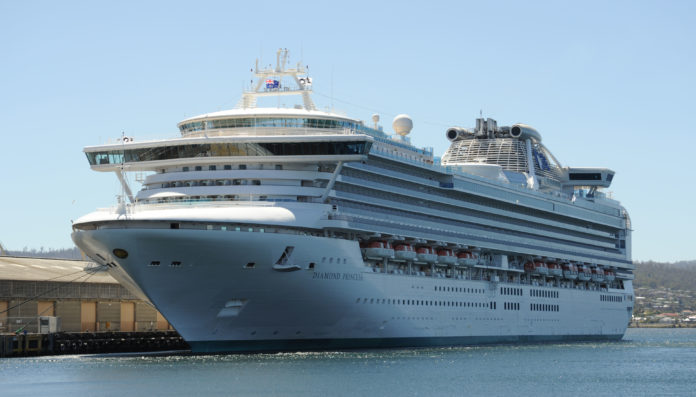
Over the past week, the cruise industry has faced a new, fast-spreading threat that has left thousands of passengers quarantined on ships and thrust the business into a global public health panic. The confirmation of the new coronavirus in cruise passengers has also served as a reminder of the risks associated with packing thousands of people into tight spaces for long stretches of time.
In a 2014 piece in the Daily Beast, infectious disease specialist Kent Sepkowitz wrote that he had dealt with flu, tuberculosis, anthrax and Ebola without any panic.
“But there is one thing that scares me to death, a single place so threatening, so teeming with contagious organisms that I can’t believe that it is a $36 billion worldwide industry – a place people pay to spend time,” he wrote at the time, referring to the gastrointestinal illness norovirus. “Cruise ships.”
After the World Health Organization declared the new coronavirus that originated in Wuhan, China, a public health emergency last week, the Cruise Lines International Association announced new restrictions meant to keep cruises free of the illness. China has reported more than 28,000 confirmed cases and more than 560 deaths.
Those measures included not letting anyone board who had been in China within the past 14 days. Some lines went even further, extending the time frame to 15 or even 30 days since someone had been in China, and put additional health screening steps into place for passengers and crew before embarkation. Operators also announced changes to planned itineraries, shifting ships away from ports including Hong Kong and mainland China.
But as it turned out, those steps were too late or just not enough. Here’s what has unfolded in the past several days.
– What are the current cruise-ship quarantines in the wake of the new coronavirus outbreak?
As of Thursday, more than 7,500 people are being kept on cruise ships off the coasts of Japan and Hong Kong – some strictly quarantined for two weeks, others awaiting test results and further instructions from land.
The Diamond Princess, part of Carnival Corp.-owned Princess Cruises, has been ordered to keep passengers on board for two weeks after 20 people so far tested positive for the new coronavirus. The ordeal started when a passenger who took a cruise from Japan to Hong Kong from Jan. 20 to 25 tested positive for coronavirus six days after leaving the ship. Authorities in Japan started screening current passengers on Monday; 10 were confirmed to have the virus on Wednesday and were taken to hospitals.
As of Thursday morning, local time, another 10 had received positive results, according to Princess Cruises. They, too, were being taken to facilities on land. Another 171 are waiting for their test results. The 20 sick include seven passengers from Japan, three each from Hong Kong and the United States, two each from Canada and Australia and one from the Philippines, Taiwan and New Zealand. The rest of the passengers – more than 2,600 – are being forced to stay in their cabins on the ship for two weeks off the coast of Yokohama, Japan.
A second ship, World Dream, was also being quarantined off Hong Kong pending test results for crew members after three passengers who sailed between Jan. 19 and 24 tested positive for the virus. The ship, which has more than 3,800 passengers and crew on board, is part of Dream Cruises. The company said in a statement Thursday that 33 crew members who had complained of symptoms including cough, sore throat and fever had negative tests for coronavirus. One more crew member who came down with a fever Wednesday night was taken to a hospital and is awaiting test results. No passengers or crew can leave the ship until those results are confirmed.
Spokeswoman Edith Poon said in an email that health checks for guests are still ongoing on the ship. “We are waiting for the Department of Health’s advice on clearance for disembark,” she said.
Taiwan banned international cruise ships from docking on Thursday, Reuters reported. And Japan’s prime minister said Thursday that foreigners would not be allowed to get off Holland America Line’s Westerdam, which left Hong Kong on Saturday, unless there were special reasons to let them disembark. Spokesman Erik Elvejord said in a statement that the ship, with 2,257 passengers and crew, had been scheduled to stop at several Japanese ports before ending in Yokohama on Feb. 15.
“We are quickly working to develop alternate plans and are keeping guests updated on board as information becomes available,” he said in a statement, adding that the ship was not in quarantine and there were no known cases of coronavirus on board at this time. The Australian Broadcasting Corporation reported that the cruise was not allowed to make a scheduled stop in the Philippines earlier this week.
Last week, 6,000 people were forced to stay on the Costa Smeralda off Civitavecchia, in Italy, while authorities awaited test results for two people. They were found to have the flu. And an Aida Cruises ship was not allowed to visit St. Lucia last weekend because some people on board had upper respiratory infections, Fox News reported.
Putting an entire cruise ship in quarantine might sound “a little bit extreme,” says Paola Lichtenberger, an infection disease specialist at the University of Miami Miller School of Medicine. But, she said, authorities are taking “desperate measures to contain the disease.”
– How does disease spread through a cruise ship?
The CDC spells out “a unique combination of health concerns” for cruise passengers, who congregate in relatively small spaces for dining, entertainment, recreation and other activities.
“Travelers from diverse regions brought together in the often crowded, semi-enclosed environments onboard ships can facilitate the spread of person-to-person, foodborne, or waterborne diseases,” the agency says. “Outbreaks on ships can be sustained for multiple voyages by transmission among crew members who remain onboard or by persistent environmental contamination.”
While the cruise industry group points to its health screening processes, frequent cleaning, inspections and onboard medical facilities as steps to keep passengers and crew healthy, experts say it’s still difficult to keep highly contagious illness from spreading.
“On a ship, look, you’re in a small town and everybody’s in, what, a half mile of each other?” says Gary Simon, director of the Division of Infectious Diseases and a professor of medicine at the George Washington University School of Medicine and Health Sciences. (The largest ships are less than a quarter of a mile long, although they have more than a dozen decks.) “These are big ships, I know. But people are in very close contact with one another, and unless you’re going to stay in your room the whole time, there’s going to be some degree of exposure.”
– Don’t people get sick on cruise ships a lot?
Several times a year, a well-publicized outbreak of stomach illness on a ship prompts a new wave of people to swear they’d never be caught on a cruise. Last year there were 10 such incidents, but the percentage of passengers on board who get sick is often relatively low. The CDC – which makes certain gastrointestinal illness outbreak information public – points out that even though health care facilities, restaurants and schools are other common settings for norovirus, the illness is known as the “cruise ship virus.”
But the agency points out that respiratory illnesses are the most common medical complaint on cruise ships, and influenza is the most commonly reported vaccine-preventable illness on board.
– How is the new coronavirus different from other illnesses that have emerged on cruise ships?
Many unknowns are making that effort more difficult, especially on a cruise ship. The CDC says it’s not yet known how easily the new coronavirus passes from person to person; whether someone can catch it from touching a surface or object that has the virus on it and then touching their own mouth, nose or eyes; or if people are contagious even when they don’t show symptoms.
– What measures are these ships taking to contain the spread?
Mainly, cruise lines are trying to keep people off if they might be sick. While the general standard is that anyone who has been in China in the last 14 days will not be allowed on a cruise, some lines are stretching the time frame further to 15 or even 30 days for passengers and crew. Health screenings are being stepped-up, and ships are avoiding going to ports where the disease has been spreading rapidly.
Operators also say they are putting enhanced cleaning and sanitation procedures in place.
– What can travelers do to protect themselves onboard?
Lichtenberger says people who are especially vulnerable – including anyone who is pregnant, small children, adults over 60, and those with suppressed immune systems or chronic diseases – should avoid getting on a cruise ship or plane in an area where there is an outbreak ongoing.
Those who do cruise, Simon says, should wash their hands frequently and avoid touching their mouth. He said that while a mask is not a foolproof way to keep from getting sick, it could be useful.
“One of the benefits of wearing a mask is you’re not constantly touching your face,” he says.
CDC guidelines on preventing influenza-like-illness among crew members on cruise ships recommends that workers stay six feet away from sick people; interact with ill passengers as briefly as possible; and limit the number of people who interact with someone who is sick. The agency also recommends using an alcohol-based hand sanitizer if soap and water is not available.
– What do travelers in quarantine on a cruise ship do all day?
On the Diamond Princess, passengers are getting food delivered to their rooms and have “in-room activities and entertainment provided,” Princess Cruises spokeswoman Negin Kamali said.
Some on board have described days passed watching television or movies, sitting on their balcony (if they have one), talking to fellow passengers via phone or over the balcony and – in some cases – making videos about the situation. Passengers are getting internet and phone use for free to stay in touch with family and friends, but have described the feeling as being in a prison. One woman said passengers are not allowed to smoke, which she said was “crucifying” her.
On World Dream, “activities have been curtailed and health screenings are being conducted in-cabin to avoid the congregating of guests as much as possible,” according to a statement. WiFi is free, and face masks are available to passengers who want them, Dream Cruises said. Crew members are helping to get supplies for the families of nine children under the age of 2 who are on the cruise.
– What about the employees of the cruise ship?
Crew members on the Diamond Princess are not being quarantined on board, Kamali said. They are delivering three meals a day to passengers in masks and doing extra cleaning and sanitation. According to the company, the ship has sailed out to sea to conduct “normal marine operations” and has been stocking up on food and supplies in Yokohama. The Wall Street Journal described workers in protective garb wiping doorknobs and other surfaces, monitoring passenger movement and taking prescription requests from passengers.
(c) 2020, The Washington Post · Hannah Sampson
{Matzav.com}











